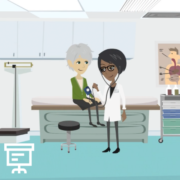What Is a JAK2 Mutation?
Editor’s Note: This resource, What is a JAK2 Mutation?, was originally published by MyHealthTeam.
One of the most commonly mutated proteins found in myeloproliferative neoplasms (MPNs) is the protein Janus kinase 2 (JAK2). This important discovery has changed how doctors diagnose and treat people with MPNs. We will be discussing both the JAK protein and the JAK gene.
MPNs are blood cancers caused by the overproduction of blood cells in the bone marrow. Mutations in the gene controlling JAK2 protein production occur most often in the three classic types of MPNs:
- Polycythemia vera (PV): Overproduction of red blood cells
- Essential thrombocythemia (ET): Overproduction of platelets
- Primary myelofibrosis (MF): Buildup of scar tissue in the bone marrow, inhibiting the production of new blood cells
The V617F mutation in the JAK2 gene is found in:
- 96 percent of polycythemia vera cases
- 50 percent to 60 percent of primary myelofibrosis cases
- 50 percent to 60 percent of essential thrombocythemia cases
Additionally, more than 50 different JAK2 mutations have been found in other parts of the JAK2 gene, primarily in PV cases.
What Is the JAK2 Gene?
The JAK2 protein plays an important role in controlling the production of blood cells from stem cells found in the bone marrow.
The JAK2 gene is responsible for genetically coding the JAK2 protein. This protein is part of the JAK/STAT pathway, which transmits signals to promote cell growth.
When the JAK2 protein is activated, it relays a signal to the protein STAT, which then binds to another STAT molecule in a process called dimerization. This group of molecules then moves into the cell’s nucleus, turning on genes that tell the cell to grow and proliferate.
What Causes JAK2 Mutations?
There are two main types of JAK2 mutations found in MPNs.
V617F Mutation
The V617F mutation is caused by a change in a single base in the genetic code. This simple change then switches the amino acid valine (V) to phenylalanine (F) at position 617 in the JAK2 protein, changing the shape of the protein. When this mutation is present, JAK2 signaling is turned on and cannot be turned off, leading to uncontrolled cell growth. In the case of MPNs, this causes an overproduction of blood cells, leading to blood cancers.
Multiple Mutations
Many different types of mutations can be found within multiple parts of the JAK2 gene. More than 50 different mutations have been identified in the gene, and almost all of these occur in people with PV.
One part of the JAK2 gene is particularly susceptible to mutations. This area genetically codes for a linker that connects two parts of the JAK2 protein. Common mutations here include deletions and insertions. A deletion is when entire pieces of the protein are lost. Insertions occur when incorrect pieces are put into the protein. Insertions and deletions change the shape of the JAK2 protein, which can affect its function.
Do JAK2 Mutations Cause MPNs?
MPNs are caused by a mutation in a single stem cell found in the bone marrow. These mutations cause the cell to rapidly divide, creating too many of one cell type. JAK2 gene mutations are involved in many cases of MPNs. In addition to JAK2 genes, mutations found in CALR and MPL genes are also common contributors to the development of MPNs. These three mutations are usually mutually exclusive, meaning that if one mutation is present, then the others are not.
JAK2 Mutations and MPN Diagnosis and Prognosis
A number of tests are required to diagnose MPNs, each providing a different piece of information. The doctor will begin with a physical examination and health history. They may also order a complete blood count (CBC) with a differential, which assesses the number of red blood cells, platelets, and white blood cells.
Because most MPNs are associated with a specific genetic mutation, a pathologist may use blood samples to test for these. Two tests used to identify genetic abnormalities are quantitative polymerase chain reaction (qPCR) and fluorescent in situ hybridization (FISH). Typically, only one of the two tests is required for diagnosis. It is also an option to perform DNA sequencing to identify the driving mutation in an MPN case.
Quantitative Polymerase Chain Reaction
Quantitative polymerase chain reaction (qPCR) is the most commonly used method for diagnosing JAK2 mutations. qPCR is also the most sensitive test, and it can detect small amounts of mutation when other methods fail.
With qPCR, DNA obtained from a blood test is mixed with a fluorescent dye, which is run through a machine that amplifies the sequences containing the JAK2 mutation.
Fluorescent In Situ Hybridization
This test determines whether someone has chromosomal abnormalities contributing to a cancerous phenotype. For example, one type of MPN, chronic myeloid leukemia (CML), is characterized by the presence of a Philadelphia chromosome (named for where it was discovered). A Philadelphia chromosome forms when two pieces of broken chromosomes stick together. This is also called the BCR-ABL1 gene, because one broken piece contains the BCR gene, and the other contains the ABL1 gene.
Most people with MPNs who are Philadelphia chromosome-negative (Ph-) have the V617F mutation in JAK2. This important discovery revealed the driving mutation behind Ph- MPNs. Before the discovery of JAK2 mutation, the cause of these defects was unknown. This also led to the development of specific JAK2 inhibitors for treatment of myeloproliferative disorders.
In 2016, the World Health Organization (WHO) revised its document “WHO Classification of Tumours of Haematopoietic and Lymphoid Tissues.” This revision included new criteria for diagnosing MPNs by the three main driver mutations in JAK2, CALR, and MPL genes. PV is characterized by the presence of a JAK2 mutation. ET and MF are characterized by the presence of any of the three driver mutations.
JAK2 Mutations and MPN Treatments
Since the discovery of JAK2 mutations in MPNs, researchers have developed a number of inhibitors targeting the protein. There are currently two JAK2 inhibitors approved by the U.S. Food and Drug Administration (FDA) for the treatment of MPNs:
Jakafi
Jakafi (ruxolitinib) is approved for treatment of MF hydroxyurea-resistant PV. It is also being investigated for use in people with hydroxyurea-resistant ET. Additionally, some trials are investigating the effects of Jakafi in combination with the antimetabolite chemotherapies Vidaza (azacitidine) and Dacogen (decitabine). Antimetabolites are a special type of cancer drug that interfere with DNA by acting as a substitute for the normal building blocks of DNA.
Inrebic
Approved in 2019, Inrebic (fedratinib) is the newest MPN drug in almost a decade. It’s used to treat three forms: high-risk MF, post-polycythemia vera MF, and post-essential thrombocythemia MF with splenomegaly (enlarged spleen).
Other JAK2 inhibitors are currently in phase 3 clinical trials, including Pacritinib for the treatment of MF and severe thrombocytopenia, and Momelotinib for the treatment of MF. These promising new drugs are in final phases of testing.
Overall, the discovery of JAK2 mutations in MPNs has helped advance drug research, development, and MPN treatment. It has also helped combat uncontrolled proliferation of blood cells, improving the lives of people with MPNs. New medications continue to be developed and tested, providing a hopeful future for those affected by myeloproliferative diseases.
Finding Support With an MPN
You are not alone living with an MPN. When you join myMPNteam, you gain a community of others who know what it’s like to face a rare blood cancer diagnosis.
Do you know whether your MPN has tested positive for a JAK mutation? Did your doctor explain what the results of the test mean for your condition? Share your experiences on myMPNteam.






















